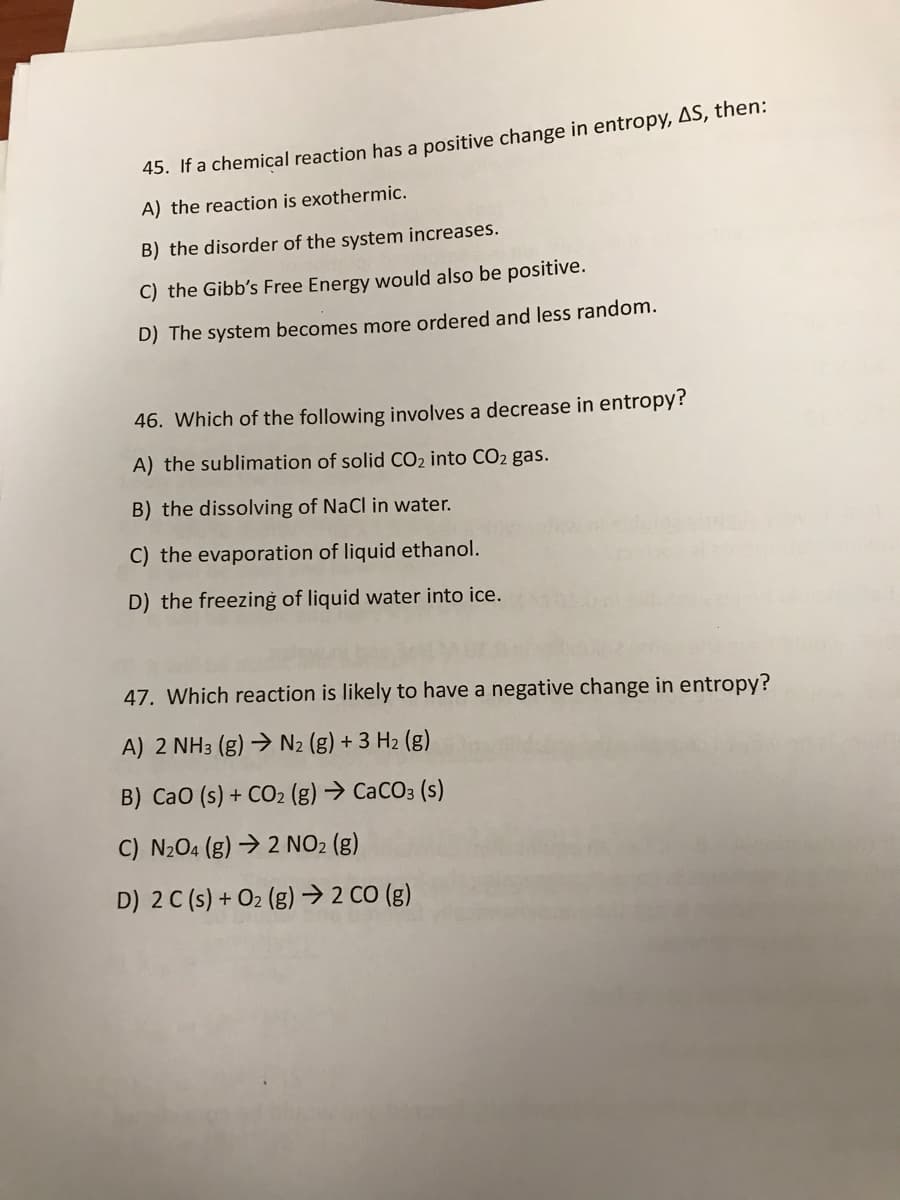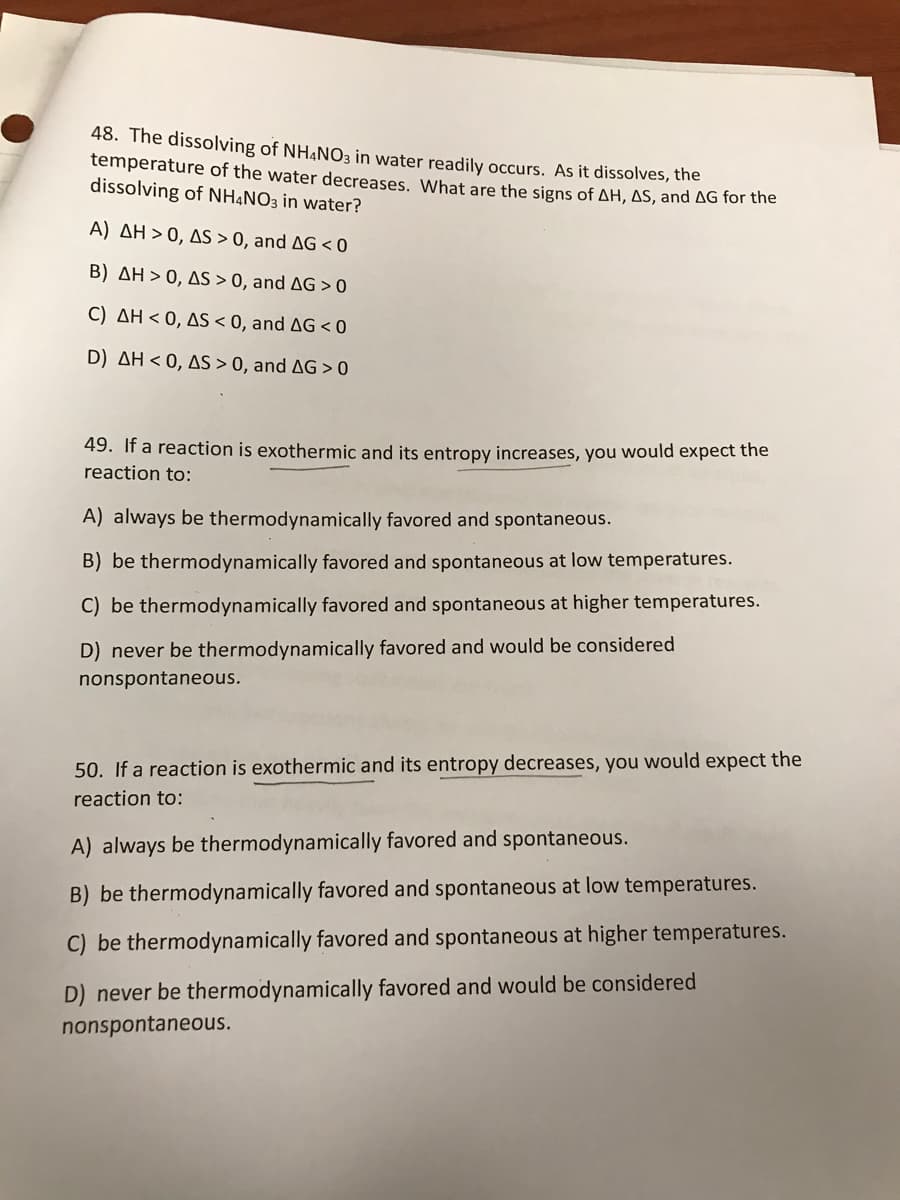45. If a chemical reaction has a positive change in entropy, AS, then: A) the reaction is exothermic. B) the disorder of the system increases. C) the Gibb's Free Energy would also be positive. D) The system becomes more ordered and less random. 46. Which of the following involves a decrease in entropy? A) the sublimation of solid CO2 into CO2 gas. B) the dissolving of NaCl in water. C) the evaporation of liquid ethanol. D) the freezing of liquid water into ice. 47. Which reaction is likely to have a negative change in entropy? A) 2 NH3 (g) → N2 (g) + 3 H2 (g) B) CaO (s) + CO2 (g) → CaCO3 (s) C) N204 (g) → 2 NO2 (g) D) 2C (s) + O2 (g) → 2 CO (g)
45. If a chemical reaction has a positive change in entropy, AS, then: A) the reaction is exothermic. B) the disorder of the system increases. C) the Gibb's Free Energy would also be positive. D) The system becomes more ordered and less random. 46. Which of the following involves a decrease in entropy? A) the sublimation of solid CO2 into CO2 gas. B) the dissolving of NaCl in water. C) the evaporation of liquid ethanol. D) the freezing of liquid water into ice. 47. Which reaction is likely to have a negative change in entropy? A) 2 NH3 (g) → N2 (g) + 3 H2 (g) B) CaO (s) + CO2 (g) → CaCO3 (s) C) N204 (g) → 2 NO2 (g) D) 2C (s) + O2 (g) → 2 CO (g)
Organic Chemistry: A Guided Inquiry
2nd Edition
ISBN:9780618974122
Author:Andrei Straumanis
Publisher:Andrei Straumanis
Chapter4: Polar Bonds, Polar Reactions
Section: Chapter Questions
Problem 4E
Related questions
Question

Transcribed Image Text:45. If a chemical reaction has a positive change in entropy, AS, then:
A) the reaction is exothermic.
B) the disorder of the system increases.
C) the Gibb's Free Energy would also be positive.
D) The system becomes more ordered and less random.
46. Which of the following involves a decrease in entropy?
A) the sublimation of solid CO2 into CO2 gas.
B) the dissolving of NaCl in water.
C) the evaporation of liquid ethanol.
D) the freezing of liquid water into ice.
47. Which reaction is likely to have a negative change in entropy?
A) 2 NH3 (g) → N2 (g) + 3 H2 (g)
B) Cao (s) + CO2 (g) → CACO3 (s)
C) N204 (g) → 2 NO2 (g)
D) 2 C (s) + O2 (g) → 2 CO (g)

Transcribed Image Text:48. The dissolving of NH4NO3 in water readily occurs. As it dissolves, the
temperature of the water decreases. What are the signs of AH, AS, and AG for the
dissolving of NHẠNO3 in water?
A) AH > 0, AS > 0, and AG < 0
B) AH > 0, AS > 0, and AG > 0
C) AH < 0, AS < 0, and AG < 0
D) AH < 0, AS > 0, and AG > 0
49. If a reaction is exothermic and its entropy increases, you would expect the
reaction to:
A) always be thermodynamically favored and spontaneous.
B) be thermodynamically favored and spontaneous at low temperatures.
C) be thermodynamically favored and spontaneous at higher temperatures.
D) never be thermodynamically favored and would be considered
nonspontaneous.
50. If a reaction is exothermic and its entropy decreases, you would expect the
reaction to:
A) always be thermodynamically favored and spontaneous.
B) be thermodynamically favored and spontaneous at low temperatures.
C) be thermodynamically favored and spontaneous at higher temperatures.
D) never be thermodynamically favored and would be considered
nonspontaneous.
Expert Solution
This question has been solved!
Explore an expertly crafted, step-by-step solution for a thorough understanding of key concepts.
This is a popular solution!
Trending now
This is a popular solution!
Step by step
Solved in 5 steps

Knowledge Booster
Learn more about
Need a deep-dive on the concept behind this application? Look no further. Learn more about this topic, chemistry and related others by exploring similar questions and additional content below.Recommended textbooks for you

Organic Chemistry: A Guided Inquiry
Chemistry
ISBN:
9780618974122
Author:
Andrei Straumanis
Publisher:
Cengage Learning


Macroscale and Microscale Organic Experiments
Chemistry
ISBN:
9781305577190
Author:
Kenneth L. Williamson, Katherine M. Masters
Publisher:
Brooks Cole

Organic Chemistry: A Guided Inquiry
Chemistry
ISBN:
9780618974122
Author:
Andrei Straumanis
Publisher:
Cengage Learning


Macroscale and Microscale Organic Experiments
Chemistry
ISBN:
9781305577190
Author:
Kenneth L. Williamson, Katherine M. Masters
Publisher:
Brooks Cole